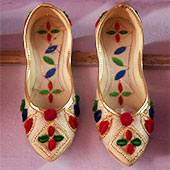Wedding is a grand occasion in one’s life which comes once in lifetime. It is almost like a festival with loads of celebration all around that is very colorful and lavish, with a slice of pomp and show creating an exciting environment. In such joyous environment bright and elaborate preparations are made in terms of food, fun, clothing, floral decorations etc. The bride and the bridegroom are decked up well with the most beautiful attire and precious jewels. Earlier it used to be only brides who were centre of attraction in the wedding but today even the grooms take all the essential measures to look as stunning as his companion. His attire and accessories are also as important as bride’s. Sherwani is one such grand and much striking Indian garments that is perfect outfit for wedding and reception parties. Sherwanis are the best wedding apparel that can be worn with a matching stole, turban and sherwani shoes. It is considered that sherwani shoes (mojari & jutti) are the most important accessory for groom. And the two words ‘mojari’ and ‘jutti’ are the Urdu words for shoe.
Juttis are a type of footwear that is common in North India and neighboring regions. These sherwani shoes are very unique when compared with other shoes. They have no right or left distinction and are round or pointed toes with flat sole. Traditionally they are made of leather from hide of buffalo or camels and the top upper portion of these shoes are made of textile which are embroidered with smooth gold jari, jardozi and salma sitara embroideries elaborately done featuring sequins, real gold and silver thread with the application of pearls, beads, precious stones and lustrous beetle wing beads. Sometimes they were also decorated with woolen pompons or tufts of material. But these days with the modern changing times sherwani shoes are made with rubber soles with variety of designs and colors. In the contemporary world shoes are preferred to be comfortable and matching the groom’s sherwani with a touch of stylish elegance. Besides these juttis there are numerous local styles as well.
Today North India has the important trading centres for handcrafted juttis in the country from where these shoes are exported to different places. These juttis have changed into quite a lot of variations in design even depending upon the shoemaker and the influence of the local flavor. But for both men and women the jutti designs are similar except in some juttis of women there is no back part (counter) near the ankle and are plain rounded or squared shape in front but in men juttis near the toe cap they have sharp extended curved tip facing upwards which are called as khussa. In this changing times though there is slight difference in style and patterns of sherwani shoes still these juttis have remained as a part of ceremonial attire. In Punjab even today this sort of shoes are worn by both men and women for everyday use.
Apart from being called as ‘Juttis’ or ‘Mojari’ sherwani shoes have an alternative name called Khussa in Pakistan and are very popular by that name in western part of India. These sherwani shoes are traditionally handed over from generations to generations with a mild variation in them. They are basically traditional ethnic Indian footwear with the toe covering upper part with beautiful embroidery work on them. They are usually M-shaped upper shoe and some are in round shape that resemble the modern day ballerina footwear. These ethnic shoes were initially worn by the Mughal emperors of the early sixteenth century and in later days it was used by wealthy nawabs, zamindars, maharajas and maharanis of India. Thus the designs of sherwani shoes are highly inspired by Mughal era and Rajasthan’s rich flora and fauna. The very common motifs used for decorating these sherwani shoes are birds, flowers, leaves and other ornate designs. These shoes have a wide range from hand-painted to embroidered, sequined designs to contemporary style. They are still more stylized these days in order to innovate something new by experimenting like cartoon characters, pop art scenes, retro images have also been designed on these shoes to give it a modern twist with a traditional touch.
The hub of making sherwani shoes originated for the first time in Rajasthan and in future days these shoes gained popularity in Punjab. Sherwani juttis are handmade shoes done by experienced skilled artisans located in remote corners of the country. But in modern days these type of juttis are found and sold in local areas of Punjab, Haryana, Rajasthan and Varanasi. These juttis are the combination of vibrant color, beauty and made for utilitarian purpose with the usage of rich gold threads and colorful beads with the exquisite motifs in order to convey the royal splash. As they seems to be an alternative ballerina shoes with an ethnic charm they are popular among the countries like US, UK, Canada, Pakistan, Middle east and Europe from several years, who have been fascinated with this Indian footwear. And some of the popular shoe brands in western part of the country have imitated these shoes in their own designs and craftsmanship.




